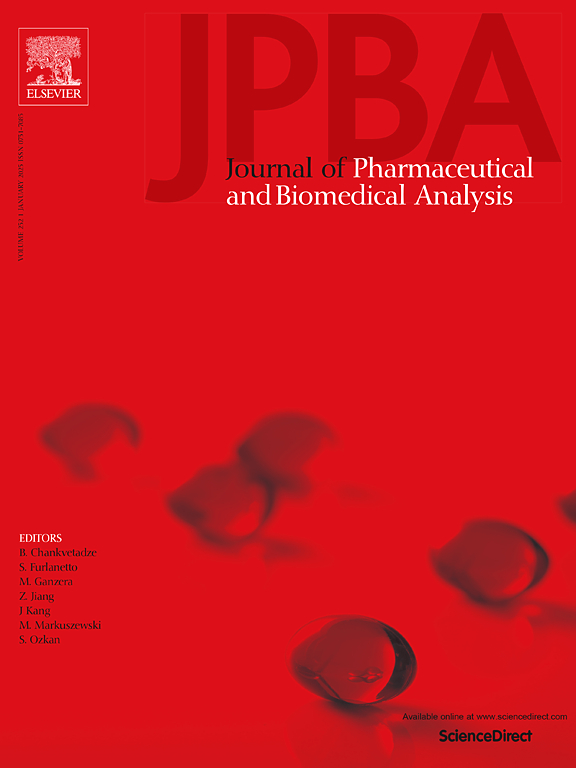Qualitative and quantitative determination of SIPI-2011 and its two major metabolites in human plasma
IF 3.1
3区 医学
Q2 CHEMISTRY, ANALYTICAL
Journal of pharmaceutical and biomedical analysis
Pub Date : 2025-05-15
DOI:10.1016/j.jpba.2025.116958
引用次数: 0
Abstract
SIPI-2011, a structural modification of isoquinoline alkaloid, is under investigation for treating arrhythmias. To characterize the safety and tolerability, the pharmacokinetics and metabolism of SIPI-2011 were investigated in humans. After an oral administration of 600 mg SIPI-2011, a total of 32 metabolites were detected in human plasma by UPLC-UV/Q-TOF mass spectrometry utilizing mass defect filter method. The principal biotransformation pathways included di-dehydrogenation (M8–1), dehydrogenation (M9–2), and oxidation and dehydrogenation (M10–4). Afterward, a sensitive LC-MS/MS method was developed to simultaneously determine SIPI-2011 and its two major metabolites M8–1 and M9–2 in human plasma. The isotopically labeled internal standards of the metabolites were obtained by incubating deuterated SIPI-2011 with rat liver homogenates. To achieve effective chromatographic retention and separation, three analytes were eluted on an XDB-phenyl column with alkaline mobile phase, and detected by multiple reaction monitoring (MRM) with positive electrospray ionization source. To reduce the interference from the isotope signals of M8–1 and M9–2 in the higher calibration point, [M+H+ 1]+ ions were selected as precursor ions of M9–2 and SIPI-2011 for MRM analysis. The assay was linear in the concentration range 15.0–3000 ng/mL for SIPI-2011, 0.500–100 ng/mL for M8–1 and 1.00–200 ng/mL for M9–2. The parameters of the method validation all met the acceptance criteria. The pharmacokinetic study indicated that SIPI-2011 was rapidly absorbed with a median Tmax of 0.65 h and a terminal half-life of 15.4 h when healthy volunteers were administered a single dose of 300 mg SIPI-2011. And the plasma exposures of the two metabolites M8–1 and M9–2 were less than 10 % of that of the parent drug.
SIPI-2011及其两种主要代谢产物在人血浆中的定性和定量测定
SIPI-2011是异喹啉生物碱的一种结构修饰,正在研究用于治疗心律失常。为了表征SIPI-2011的安全性和耐受性,研究了SIPI-2011在人体内的药代动力学和代谢。口服600 mg SIPI-2011后,采用UPLC-UV/Q-TOF质谱法检测血浆中32种代谢物。主要的生物转化途径包括二脱氢(M8-1)、脱氢(M9-2)和氧化脱氢(M10-4)。随后,建立了一种灵敏的LC-MS/MS方法,同时测定SIPI-2011及其两种主要代谢物M8-1和M9-2在人血浆中的含量。将氘化SIPI-2011与大鼠肝脏匀浆孵育,获得代谢物的同位素标记内标物。为了实现有效的色谱保留和分离,用碱性流动相xdb -苯基柱洗脱3种分析物,用正电喷雾电离源进行多重反应监测(MRM)检测。为了减少M8-1和M9-2同位素信号在较高定标点的干扰,选择[M+H+ 1]+离子作为M9-2和SIPI-2011的前体离子进行MRM分析。SIPI-2011的浓度范围为15.0 ~ 3000 ng/mL, M8-1的浓度范围为0.500 ~ 100 ng/mL, M9-2的浓度范围为1.00 ~ 200 ng/mL。方法验证参数均符合验收标准。药代动力学研究表明,健康志愿者单次给药300 mg SIPI-2011时,SIPI-2011吸收迅速,中位Tmax为0.65 h,终末半衰期为15.4 h。两种代谢物M8-1和M9-2的血浆暴露量小于母体药物的10 %。
本文章由计算机程序翻译,如有差异,请以英文原文为准。
求助全文
约1分钟内获得全文
求助全文
来源期刊
CiteScore
6.70
自引率
5.90%
发文量
588
审稿时长
37 days
期刊介绍:
This journal is an international medium directed towards the needs of academic, clinical, government and industrial analysis by publishing original research reports and critical reviews on pharmaceutical and biomedical analysis. It covers the interdisciplinary aspects of analysis in the pharmaceutical, biomedical and clinical sciences, including developments in analytical methodology, instrumentation, computation and interpretation. Submissions on novel applications focusing on drug purity and stability studies, pharmacokinetics, therapeutic monitoring, metabolic profiling; drug-related aspects of analytical biochemistry and forensic toxicology; quality assurance in the pharmaceutical industry are also welcome.
Studies from areas of well established and poorly selective methods, such as UV-VIS spectrophotometry (including derivative and multi-wavelength measurements), basic electroanalytical (potentiometric, polarographic and voltammetric) methods, fluorimetry, flow-injection analysis, etc. are accepted for publication in exceptional cases only, if a unique and substantial advantage over presently known systems is demonstrated. The same applies to the assay of simple drug formulations by any kind of methods and the determination of drugs in biological samples based merely on spiked samples. Drug purity/stability studies should contain information on the structure elucidation of the impurities/degradants.

 求助内容:
求助内容: 应助结果提醒方式:
应助结果提醒方式:


